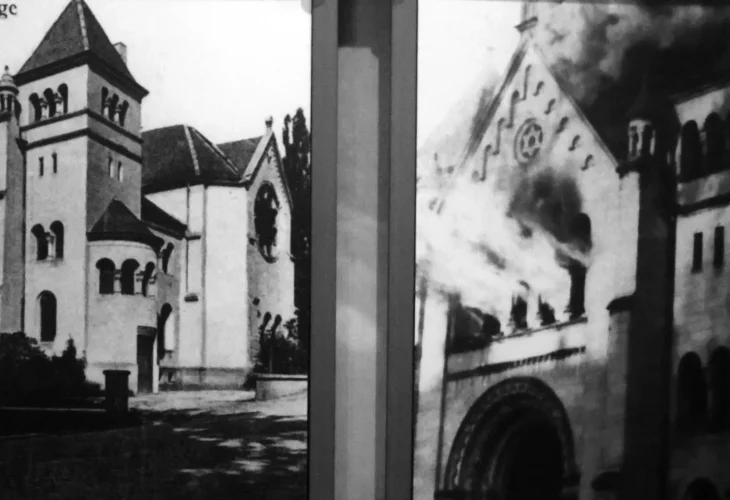The Children of Cologne: A Tale of Survival and Heritage
In Roman times, Jews in Cologne thrived and were recognized as a permitted religion, long before Christianity became dominant. Their community was influential enough to participate in city council elections, and their intellectual leaders were exempt from military and civil service.
 Kristallnacht (Photo: shutterstock)
Kristallnacht (Photo: shutterstock)We've become accustomed to the idea of Ashkenazi Jews, but it wasn't always like this. During the Second Temple era, and even before that, Jewish communities existed across hundreds of countries, in Egypt, Africa, Babylonia, Persia, Asia, and even Hispania (modern-day Spain). Yet, Ashkenazi Jews were not part of this map, as Western European countries like France and Germany were outside the realm of civilized habitation, inhabited by tribes labeled as "barbarians" by the Romans.
On November 9, 1938, also known as Kristallnacht, a furious Nazi mob wreaked havoc in the streets of Cologne, then home to 20,000 Jews. They burned the synagogue to the ground and unleashed their fury on Jews and Jewish establishments. In a response article by Menachem Kalivinsky, head of the school in Cologne, he wrote, "The incited mob shouted 'Germany for Germans,' but Jews lived in Cologne long before the Germans migrated here!" Kalivinsky successfully sent 130 of Cologne's children to England via the Kindertransport, saving them from death, but he was ultimately murdered by the Germans.
Kalivinsky's statement that "Jews lived in Cologne long before the Germans migrated here" is indeed accurate, infuriating the Germans. The original name of Cologne is "Colonia," referring to its Roman founders who, in 38 BCE, established the settlement along the east bank of the Rhine on Emperor Marcus Agrippa's orders, decades before the Temple's destruction. The Romans held control until 456, when the Franks captured it. Germans arrived much later.
Jews arrived with the Roman army, and there are signs of their presence in Cologne even before the Temple's destruction. One archaeologist, the German scholar Sven Schutz, excavated beneath the foundations of the medieval synagogue in Cologne and discovered more ancient remains, including ten Hebrew inscriptions. Schutz, not understanding Hebrew, sent these inscriptions to experts. He humorously recounted to the media that one inscription, which appeared significant and grand, was sent for translation, only to be revealed as a mere directional sign to the restroom...
In Roman times, Jews in Cologne thrived as a recognized "permitted religion," well before Christianity took hold of the Roman Empire. They lived prosperously, with the ability to run for city council. Their intellectuals received exemptions from military and civil services. As noted in the Theodosian Code: "We permit all city councils to appoint Jews to the curia by general law. To compensate them for previous laws, we determine that two or three of them shall enjoy the right not to be called for any public service."
The synagogue was granted an imperial privilege safeguarding its rights.
The Nazis were justifiably enraged by these historical facts. Jews were present in parts of Germany before them, with no less legitimacy...
Cologne was the pioneer community of Ashkenazi Jews, with Jewish presence persisting for most of its history. However, the communities of SHUM—Speyer, Worms, and Mainz—later overshadowed it. About 700 years ago, the Maharil recounted that it was tradition that Jews had lived in Venice a thousand years prior, suggesting settlement as early as the third century CE. The significant turning point for Mainz and SHUM communities was the migration of Torah scholars from Italy to Ashkenaz.
The Kalonymus family, a noble and renowned family from Lucca, Italy, composed of wealthy traders and exceptional Torah scholars, were invited by Emperor Charlemagne in 787 to relocate to Mainz, to educate the Jewish population there in the Torah and mold them into righteous individuals. Some suggest this was to boost trade in the Rhine cities. Regardless, the Kalonymus family's migration, followed by many other Jews, not only advanced trade but also Torah study.
In addition to the Kalonymus family, Rabbi Leon, known in greater detail by his students as "Rabbeinu Yehuda HaKohen Leon the Elder," also embarked from Italy to Mainz and left an indelible mark. Rabbeinu Gershom, the luminary of the Jewish exile, writes: "Rabbi Leon, my teacher from whom I learned most of my Talmud, was an exceptional sage… I relied on Rabbeinu Leon's words… I consider Rabbeinu Leon's contributions exceptional in his generation, and no one changes after his words."
Rabbi Leon lived during the time of Rab Sherira Gaon and was a parallel authority for Ashkenazi Jewry. Customarily, Torah novelties were not documented in writing at the time, so we have no writings from him, only from his students' students. Nonetheless, his name and memory endures among the early Ashkenazi sages as a leader and scholar, interpreter and poet, who established prayer customs and mitzvot practices, eventually passed down to his student and descendant, the holy Rashi.

